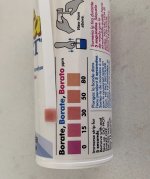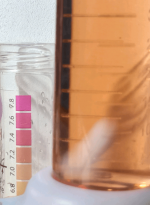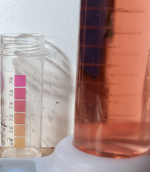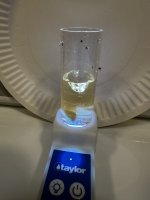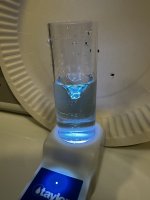- Mar 5, 2020
- 3,221
- Pool Size
- 66000
- Surface
- Plaster
- Chlorine
- Salt Water Generator
- SWG Type
- Astral Viron V35
Hi @JoyfulNoise
I'm still not 100% clear about the reason for this step:
I understand that at pH 4.5 almost all of the carbonates will be in the form of dissolved CO2. But the CO2 remains in the water unless we give it time to outgas with a corresponding TA-neutral pH-rise. But when we immediately bring pH back up again to 7.0 to 7.5 with sodium hydroxide, the carbonates will reshuffle again, and we are back to most of the carbonates being HCO3- as before. So, I don't fully understand the reason for reducing pH all the way down to TA=0. I understand that we need to get quite far down so that we can adjust pH with more than just a fraction of a drop of R0010 to where we want it before adding Mannitol.
So, what really is difference between lets say (just example numbers, don't nail me down on them)
I did see a small difference in the end results (which may or may not be significant) as reported above, but I still don't fully get the reason for going all the way down to pH 4.5.
I'm still not 100% clear about the reason for this step:
Then I would make sure that you are initially adjusting the pH with R-0009 until you get to a pH below 4.5 as that is when carbonate alkalinity is fully (almost) converted to aqueous CO2. Then adjust back up to 7.0-7.5 (doesn’t matter much)
I understand that at pH 4.5 almost all of the carbonates will be in the form of dissolved CO2. But the CO2 remains in the water unless we give it time to outgas with a corresponding TA-neutral pH-rise. But when we immediately bring pH back up again to 7.0 to 7.5 with sodium hydroxide, the carbonates will reshuffle again, and we are back to most of the carbonates being HCO3- as before. So, I don't fully understand the reason for reducing pH all the way down to TA=0. I understand that we need to get quite far down so that we can adjust pH with more than just a fraction of a drop of R0010 to where we want it before adding Mannitol.
So, what really is difference between lets say (just example numbers, don't nail me down on them)
- adding 10 drops of R0009 to get down to pH 6.0 and then adding 1 drop of R0010 to get pH to maybe 7.2
- adding 14 drops of R0009 to get down to pH 4.5 and then adding 2 drops of R0010 to get pH to maybe 7.3?
I did see a small difference in the end results (which may or may not be significant) as reported above, but I still don't fully get the reason for going all the way down to pH 4.5.


